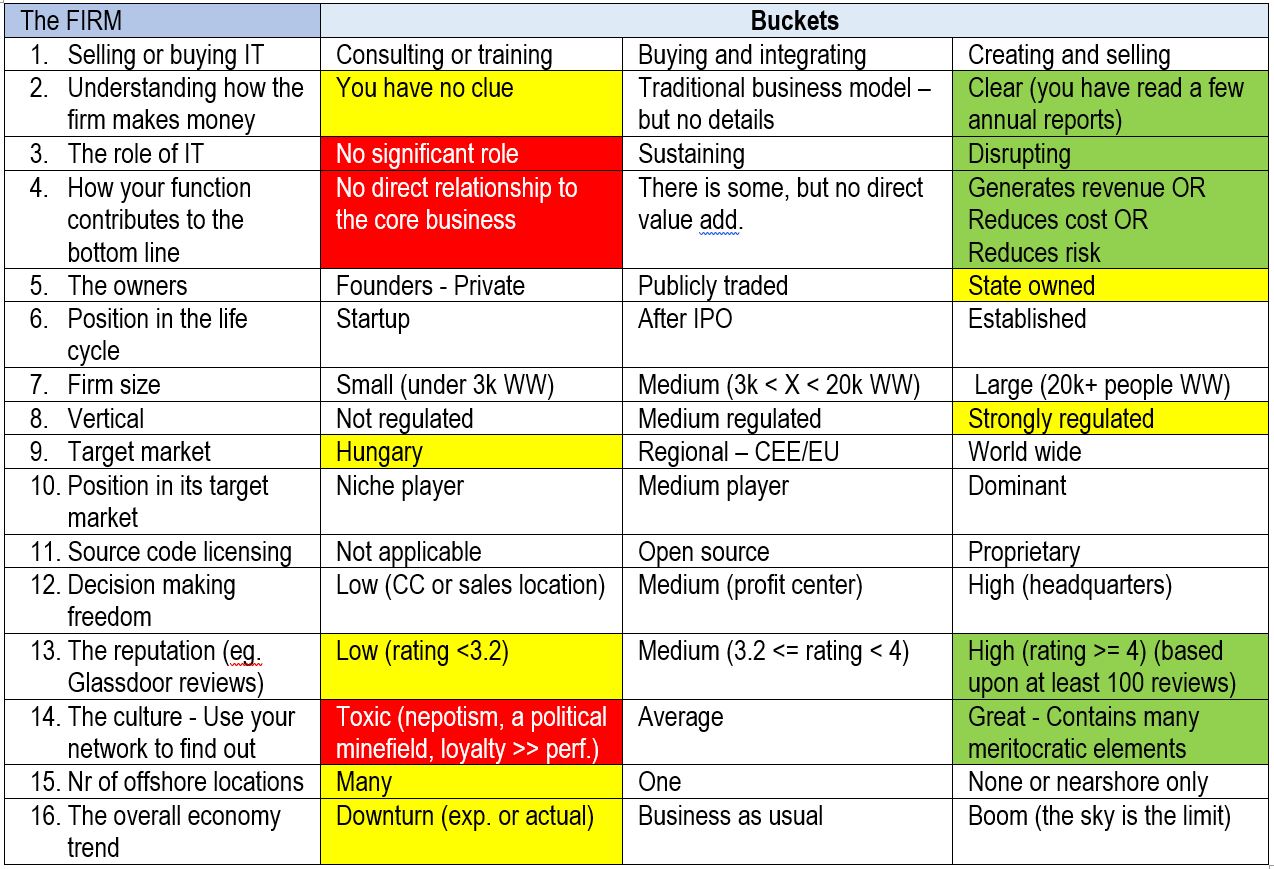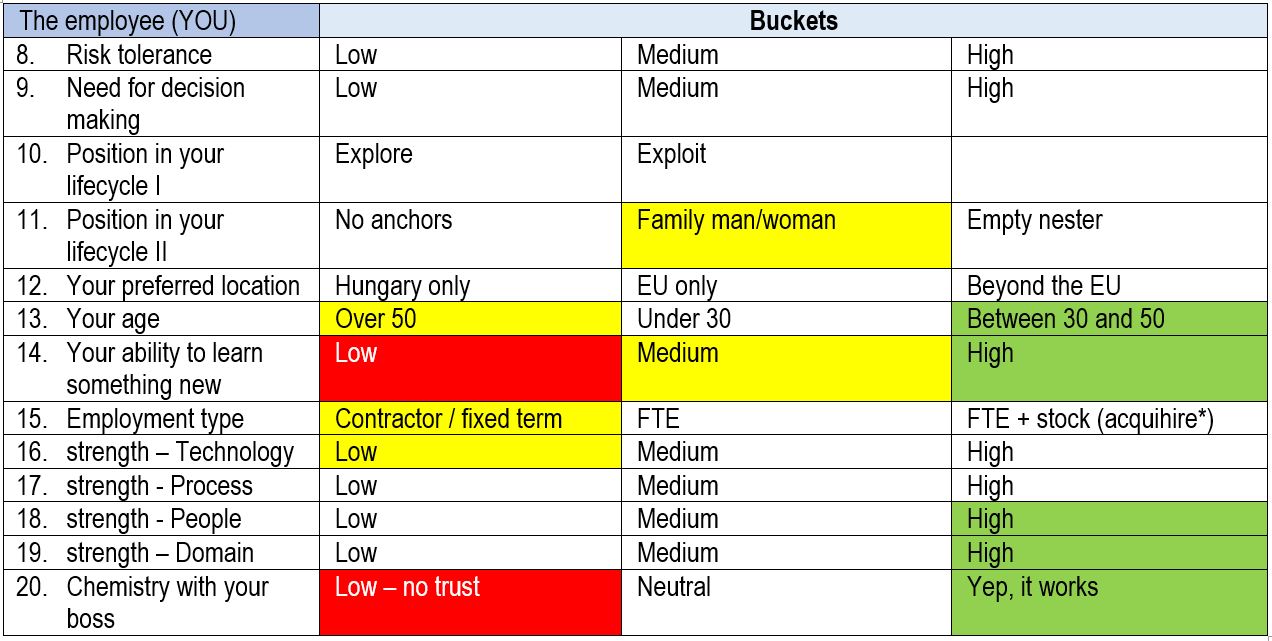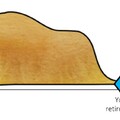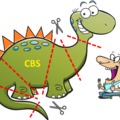I have been tinkering with the taxonomy of the Hungarian IT job market for a while. My goal was to find dimensions that could assist job seekers to pair their strengths and aspirations with the available options. Last week a friend of mine asked me to meet his buddy, a talented young telco executive who was considering a position at a company I knew fairly well. The conversation evolved around the various aspects of the firm and the job, so I gave a try and used this draft decision support sheet to provide a framework for the discussion.
The four entities we evaluated were as follows:
- The firm – to be precise a given site of the firm (in case of companies with a WW or regional footprint). One of the first decisions is if you plan to stay in Hungary or not.
- The product or service the job is related to – in case of large companies there can be several product lines independent from each other, so you need to go one layer deeper.
- The job – most hiring managers hate to write proper job descriptions, while nailing the core aspects of the job is key to find the right match.
- The employee – how your skills and preferences match the features of the other 3 entities.
The assessment of some of these buckets are dependent on the preferences of the person, eg. some just cannot live without being in the drivers’ seat, some others do not care, while appreciate a 3-4 days a week Working From Home (WFH).
For this reason, most features in the following tables are not good or bad: eg. a small company can be as good as a giant or integrating dozens of off the shelf components can be as exciting as building one of them at a SW vendor. On the other hand, I did some color coding where I had an opinion. (green = good, yellow = warning, red = stay away)
Most categories are straightforward, but there is one from a former big boss of mine that should be considered by every job seeker. He framed the activities he cared about in an IT organization like this: increase revenue, reduce cost or reduce risk. As a rule of thumb, stay away from any function that does not fall into these three buckets. The good news: more and more verticals realize that they might be the next target of a disruption, therefore they need to embrace digitalization faster than they have thought before. This means more appetite for ICT services.
I highlighted the business model, ie. the way the firm makes money. While this is perfectly valid for a startup or a brand-new unit within an established firm, no firm can burn investor money endlessly. If there is no clearly articulated business model or the numbers look bad for several years, you can be assured a merger or acquisition is lurking around.
Pay attention to the owner structure and any major changes in it. (eg. the departure of the founders is a sign of a coming storm.) In any case they are the harbinger of turmoil in the culture of the firm, in most cases with a complete overhaul of the management ranks.
There are categories that tend to move in sync, eg. most disruptor firms deliver their service as SaaS, while most established Enterprise SW players need to maintain their on prem installed base while moving their core offerings to the cloud. Nevertheless, I kept them as separate items.
After all these notes, here we go.
The characteristics of the firm
A few comments:
- Glassdoor reviews: check out if there is a large number of positive reviews that came in within a short period of time. Firms with a sluggish track record tend to beautify their score by gently pushing their staff to write nice reviews in a burst.
- If the firm claims that they have a public cloud-based offering, check it out. the proof of the pudding is in the eating.
- Size matters: an oil tanker is more likely to weather a storm than a speedboat, while the greater the firm becomes the more likely it will be more and more process driven. Processes and innovation are not close friends. This is not by accident that large firms create “Skunkworks” where they liberate their best engineers from the oppression of processes.
- There are verticals where regulation is the norm. (eg. law enforcement, pharma or investment banking). This is a “take it or leave it” situation, if you can live with it, they can be a great place to work for, if heavy weight regulation drives you nuts, chose something else.
- The issue with any IT firm collecting revenues solely from Hungary is twofold: EMEA is roughly one quarter of the WW ICT spending, Eastern Europe is around 14% of the EMEA market, Hungary is cca. 4% of CEE. Bottom line: The Hungarian market is tiny (0.1-0.2% of the WW cake). There is a glass ceiling to growth. The other problem the state is overrepresented in this mix.
- Licensing (in case of a SW company): while everybody loves open source as a buyer, few people think about how these firms make money. As long as you are a giant who create and give away your IP (intellectual property) in order to innovate in your core business AND to boost the acceptance of your stuff and to find new team mates, while you make your revenue from something else, this is a great thing. As soon as you live from support and professional services only, you will realize its limitations. These scale linearly with the number of staff, therefore are capped at 15-20% margin, while in case of SW license there is no linearity (until you competition arrives).
- No hiring manager or recruiter will tell you about their toxic culture. You have the find it out for yourself. One method is the “Exodus meter”, that is checking the number of people in LinkedIn with the target firm as their previous employment. If you find a large number who left within a short period of time, then there is something wrong. If detected, ask around.
- Multiple SSC-s (shared service centers) mean a strong focus on cost control and risk mitigation, read internal competition and a potential fragmentation of functions where it is difficult to step up regarding product ownership.
The characteristics of the product or service
A few comments:
- Bodyshop: the same profitability cap exists in this case like the one with OS SW firms, on the other hand this can be a good entry point to the firm you are sold to.
- An on prem only product in 2019 is yellow flag. This firm is likely to face the ”Innovator’s dilemma”. Many of these companies are dead by the time they figure out what went wrong.
- Watch out for end of life technologies and end of life products. This is extremely difficult to build a career on top of these.
- Decision making power is a zero-sum game: if you are not in the HQ, you need to “earn your bones” first before you will be listened to at the big guys’ table.
The characteristics of the job
A few comments:
- Whenever you are green from envy when you hear about the money sales folks take home, keep in mind: you are worth as much as your last quarter and sales is not for everybody, it is a tough job.
- If you want to be in the loop, you have to be on those meetings where decisions are made. If the HQ is in California, that means long nights away from the family. Do not fool yourself, you cannot get away with a single evening per week.
The characteristics of YOU
A few comments:
- The key question is if you want to continue exploring, that is learning new stuff, new technologies and new people or you want to exploit what you already learned. Warning: you cannot fall into full exploit mode until the age of 60 or you will be stranded soon.
- There is this freaking age thing: For a while you may compensate the decreasing RPM with an increase torque, but around 55 you suddenly face a perfectly able competition 15-20 years younger than you. The good news: there is a growing appetite for reasonable ICT people, so not all hope is lost, just trim your expectations.
- A word on the big money waiting for you in London, New York etc. Yes, you can earn up to 3 times more, but there is a caveat: your living cost will increase the same way, housing in particular. When you move out of city, you save on the rent but spend your life in commute. At the end of the day, your overall standard of living may stay the same.
- There is a major difference about how the job market works in NY and in Budapest: In NY contractors earn significantly more than FTEs, since the market knows that they run with a lower utilization (ie. they earn nothing between two assignments). In Hungary contractors earn the same or less than FTEs, and lack all the perks coming with it.
Checking all these points above took us a good 2 times 2 hours discussion, but I think it was worth it. The fun begins when you create small matrices cross referencing the items in various dimensions.
As always, I appreciate any feedback of comment on this blog post.
PS: “The world according to Garp” is one of my favorite books from John Irving. This blog post is the ICT job market according to my knowledge, hence the title.








